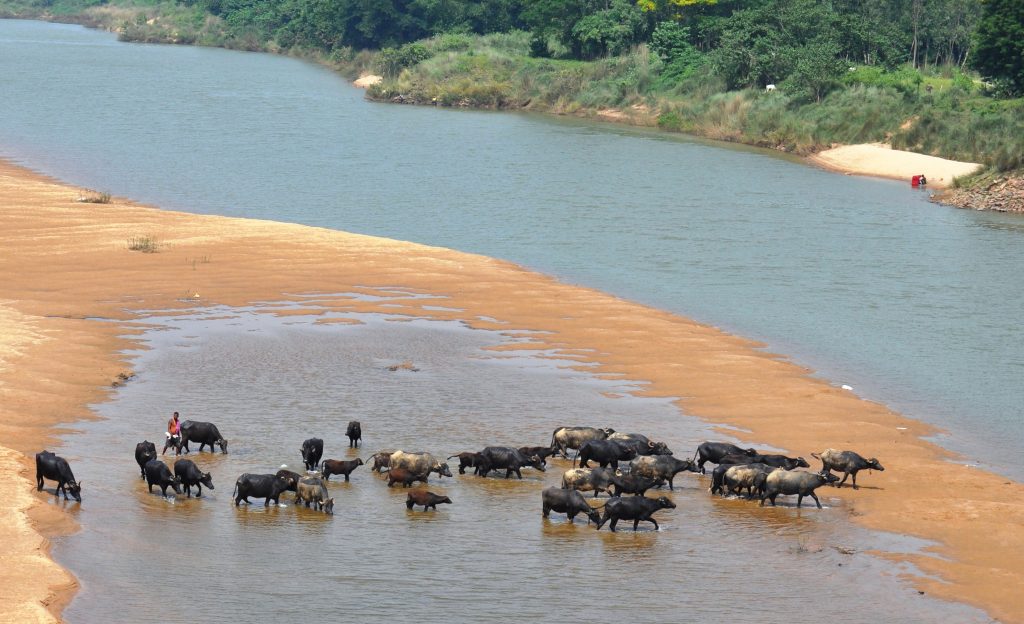Jajpur: Pollution in Brahmani river continues unabated while Gangua nullah in Bhubaneswar is the most polluted water body, a report presented April 13 by state Water Resources secretary Devidutta Ramani Ranjan Pattnaik, said. According to the report, pollution has been continuing unabated in Brahmani and Serua rivers. The state pollution control board (SPCB) declared the water flowing in 16 rivers and three nullahs in the state as polluted in 2017. This has happened due to the discharge of toxic effluents by the industrial plants which have come up near the river banks and other water bodies. It has been alleged that Brahmani river is getting polluted due to the apathetic attitude of the administration. It has been seven years since the Orissa High Court passed an order to install effluent treatment plants (ETPs) on river banks to treat the polluted water from industries.
However, no effort has been made to follow the Orissa High Court’s order. In its report, the SPCB measured the pollution level in these rivers and nullahs on a scale of one to five. Scale-1 means the highest level of pollution while scale 5 is the lowest level. Brahmani, Kathajodi and Serua rivers and the two nullahs Gangua and Guradiha have been put on scale 4. On the other hand, the pollution level in Gangua nullah in Bhubaneswar has been marked at scale-3 while that of the Guradiha nullah in Rourkela is on scale 4, denoting a high level of pollution.
Similarly, water of Daya river which flows from Bhubaneswar to Bargarh, the water of Brahmani river from Rourkela to Biritola, the water of Kathajodi river from Cuttack to Urali and the water of Serua river from Khandeita to Sankhatras have a high level of pollution. Sources said that all these rivers vary between scale-3 and scale-5 respectively. Earlier, the pollution level in Gangua nullah was on scale-1 which has improved with time and come down to scale-3.
However, Gangua continues to remain the highest polluted water body among the 19 rivers and three nullahs. Expressing concern over rampant pollution in some major river and water bodies, the National Green Tribunal (NGT) had directed to conduct a probe into the matter and find out solutions through a five-member committed led by the Principal Secretary of State Forest and Environment Department. The directors of the Environment, Town Planning and Industries departments as well as the secretary of SPCB were the members of this committee. The committee was named the River Rejuvenation Committee (RRC).
During the probe, the committee found out that the Brahmani and Kharasrota rivers which flow through the industry-based Jajpur district have become seriously toxic due to the discharge of effluents by industrial plants in this district, Sundargarh and Angul. The wastewater of various mines in Sukinda mining area of Jajpur district is also discharged into Damsala nullah which then flows into Brahmani river and pollutes its water. As a result, Brahmani river has been identified as a polluted river since 2017.
In 2017, the bio-oxygen demand (BOD) in the river water was 6.0 mg/litre while it rose to 7.6 mg/litre in 2018. The BOD in 2019 was 5.3mg/litre, 6.3mg/litre in 2020, 5.6mg/litre in 2021, 5.7mg/litre in 2022 and 5.7 mg/litre in 2023. According to SPCB, the water of Brahmani river is on scale-5.
Similarly, the Gangua nullah in Bhubaneswar had a BOD of 39.0mg/litre in 2017 while its BOD was found at 18.0mg/litre by February, 2023. The BOD of Daya river from Bhubaneswar to Bargarh was 7.3mg/litre in 2017 and 4.8mg/litre by February, 2023. The BOD of Guradiha nullah in Rourkela was 11.3 in 2017 and 8.0mg/litre by February, 2023.
The BOD of Kathajodi River was 11.2 in 2017 and it has come down to 3.8mg/litre by February 2023 while that of Serua River from Kahndeita to Sankhatras was 4.8 in 2017 and 3.6mg/litre in February 2023. The SPCB has given priority to making these rivers and water bodies pollution-free. The SPCB has also termed 12 rivers such as Mangala, Nagavali, Ratnachira, Nandirajor, Kuakhai, Mahanadi, Rushikulya, Bhden, Kusumi, Nuara Sabulia and Budhabalanga as well as Banguru nullah as pollution free.
